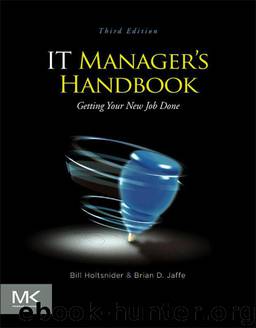IT Manager's Handbook: Getting Your New Job Done by Bill Holtsnider & Brian D. Jaffe

Author:Bill Holtsnider & Brian D. Jaffe [Holtsnider, Bill & Jaffe, Brian D.]
Language: eng
Format: epub
Tags: Business & Economics, Information Management, Computers, Information Technology, Enterprise Applications, General, Databases, Networking
ISBN: 9780123914057
Google: kwY9NMc8GwoC
Amazon: B007K6TLXE
Publisher: Elsevier
Published: 2012-03-29T16:00:00+00:00
6.2 The Difference between Capital Expenditures and Operating Expense Items
A budget usually consists of two sets of numbers: one for capital expenditures and one for operating expenses. Typically, these are considered separately, with different amounts of scrutiny. IT is a bit of an odd duck department in the budgeting process in that it usually has a significant capital budget. After all, most of the traditional corporate departments (Marketing, Finance, HR, etc.) usually don't have much need for acquiring assets.
• Whenever you spend money on something, you'll have to consider if an item is a capitalized or operating expense so that it can be treated accordingly in the accounting process. A capital expenditure is for an item that will have a useful life of several years, such as a piece of hardware. Examples of capital expenses would include most hardware, software, Enterprise Resource Planning (ERP) solutions, furniture, physical plant items (e.g., cabling, data center cabinets), and so on.
• Alternatively, an operating expense item is something whose value is gone in a shorter period of time. Operating expenses are the cost of resources used to support the ongoing operations of a business. They often recur, in that they have to be paid each month or quarter (e.g., the electric bill or salaries). Operating expenses are for items that last for a short time and have no residual value after that period. Examples of operating expenses would include salaries, telecom lines, software and hardware maintenance agreements, equipment rentals, etc. A software support agreement, for example, is an operating expense item. The value of the money spent each year lasts only for the 12 months of the agreement.
Capital Expenditure Details
If the useful life of a $10,000 router is expected to be five years, accounting principles of capital depreciation allow you to spread the cost over the life of the equipment—in this case five years. So, even though the company may have to write a check for the full amount when it buys the equipment, the impact of this purchase on the company's books, and your department's budget, may only be $2,000 that first year and in each of the subsequent four years of the device's expected life.
Because there is more paperwork involved in tracking a capitalized expense for each year of its useful life, there is generally a minimum dollar amount for capitalizing items. For example, a computer cable might be useful for 10 years, but because it only costs $25, it would not be capitalized. The minimum amount for capitalizing varies from company to company. Figures of $500, $1,000, or $1,500 are common—check with your Accounting department.
Although the useful life of a connection to the Internet might seem to be quite long, in reality its useful life is only as long as your last payment to the carrier. Stop paying the carrier and its life drops to zero. Since you're really just renting it from the carrier, it can't be considered an asset on the books of your organization.
Check with Your Company's Policies
You'll
Download
This site does not store any files on its server. We only index and link to content provided by other sites. Please contact the content providers to delete copyright contents if any and email us, we'll remove relevant links or contents immediately.
Algorithms of the Intelligent Web by Haralambos Marmanis;Dmitry Babenko(16235)
Azure Data and AI Architect Handbook by Olivier Mertens & Breght Van Baelen(7674)
Building Statistical Models in Python by Huy Hoang Nguyen & Paul N Adams & Stuart J Miller(7657)
Serverless Machine Learning with Amazon Redshift ML by Debu Panda & Phil Bates & Bhanu Pittampally & Sumeet Joshi(7529)
Driving Data Quality with Data Contracts by Andrew Jones(7293)
Data Wrangling on AWS by Navnit Shukla | Sankar M | Sam Palani(7290)
Machine Learning Model Serving Patterns and Best Practices by Md Johirul Islam(7031)
Learning SQL by Alan Beaulieu(6237)
Weapons of Math Destruction by Cathy O'Neil(6215)
Big Data Analysis with Python by Ivan Marin(5934)
Data Engineering with dbt by Roberto Zagni(4931)
Solidity Programming Essentials by Ritesh Modi(4565)
Time Series Analysis with Python Cookbook by Tarek A. Atwan(4399)
Pandas Cookbook by Theodore Petrou(4087)
Blockchain Basics by Daniel Drescher(3540)
Natural Language Processing with Java Cookbook by Richard M. Reese(3143)
Hands-On Machine Learning for Algorithmic Trading by Stefan Jansen(3045)
Learn T-SQL Querying by Pam Lahoud & Pedro Lopes(2930)
Feature Store for Machine Learning by Jayanth Kumar M J(2926)
